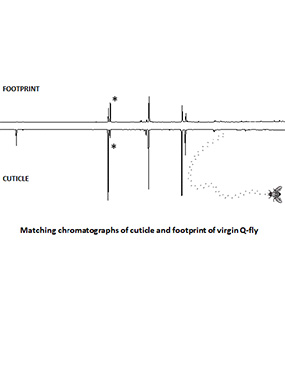
The smell of footprints in Q-fly
Cuticular hydrocarbons (CHCs) that cover the cuticle of insects have been studied for their role in preventing desiccation as well as for their function as ‘infochemicals’. The study of the chemical ecology of tephritid fruit flies has mainly focused on volatile pheromones released by males to attract females at long range; little is known about cuticular compounds and their role in close contact communication. We recently found that the CHC profile of Queensland fruit flies (Q-flies) varies with both sex and maturity. Q-flies leave CHCs behind as they walk on surfaces (‘footprints’), and the chemical profile of the surface where the fly walked matches exactly the fly’s CHC profile. Footprints might be used by conspecifics to obtain information about sex and maturity of the fly, to identify sites for mating aggregations that assemble each dusk, or to guide oviposition decisions. Footprints might also be used by predators to find flies as prey.
We are investigating how long Q-fly footprints persist in nature, how Q-flies use CHC footprints to inform decisions of mating and oviposition, and whether predators use Q-fly CHC footprints to inform hunting. This is the first study of CHC footprints in a true fruit fly and is lifting the veil on an entirely unexplored dimension of fruit fly biology and predator-prey interactions. We are also exploring the potential use of footprint chemistry for the management of major fruit fly pests.
Funding: Australia & Pacific Science Foundation
Contact: Dr Vivian Mendez